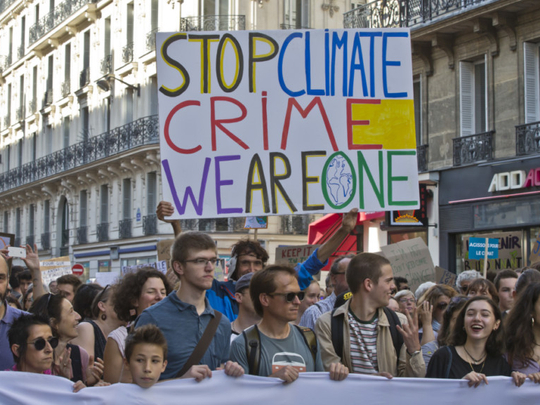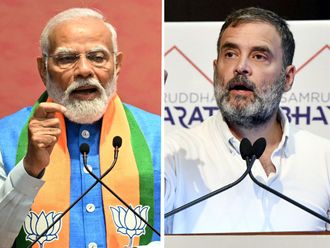
Donald Trump acknowledged on Friday that he has not looked at the hard-hitting report from the UN’s Intergovernmental Panel on Climate Change (IPCC) released in recent days. The landmark study asserts that there may be only a dozen years to prevent the worst impacts of so-called ‘runaway’ global warming, potentially fuelling pessimism about the future of global efforts to combat climate change.
Yet, while the scale of the challenge is huge, and growing, actions can still be taken by governments, businesses and individuals that are affordable and feasible to turn this situation around. And this can be done under the flexible 2015 Paris treaty, which has the potential to be ratcheted up.
In a clarion wake-up call to the international community, the IPCC makes clear that only urgent, unprecedented political and economic action can avoid worsening risks of future drought, extreme heat, and floods across the globe. The central challenge, according to the UN body, is keeping temperature rises to no more than the 1.5 degree Celsius mark above pre-industrial levels, which was the target set by Paris. Yet, the IPCC warns that there is now a very high risk that, under current emission trajectories, global warming will exceed that amount, perhaps significantly so.
While the difference between a 1.5 degree rise and higher may seem inconsequential to some, the difference is profound according to the IPCC. For instance, the portion of the global population subject to water stress could be 50 per cent lower with overall warming of 1.5 degrees compared to 2 degrees.
Equally, ice-free summers in the Artic would occur around once every 100 years at the lower target, but perhaps every decade at the higher target according to the IPCC. Meanwhile, a forecast 99 per cent of corals could be lost at the 2 degree rise compared to perhaps 10 per cent at 1.5 degrees.
The report, which will be formally delivered to governments at the UN climate conference in Poland in December, warns clearly that the world may currently be on course for disastrous warming of 3 degrees Celsius. However, this pathway can potentially be changed through proactive, concerted global action.
To be sure, there are some encouraging trends here, including the fact that China is currently drawing up a long-term global warming plan. Conversely, the Trump team continues to flout climate science, while Brazilian presidential candidate Jair Bolsanaro could win power this month with his plans for leaving Paris, abolishing his nation’s environment ministry, and potentially allowing much more mining, logging and other business in the Amazon with significantly greater deforestation.
In this context, pro-Paris countries will need to raise their ambition and ratchet up their emissions cuts in future. And the IPCC report sketches out several ways in which changing land use, and technological change, including utilisation of carbon capture materials and clean energy public transport systems, could help achieve the 1.5 degrees Celsius target.
This underlines that while Paris was a welcome shot in the arm for attempts to tackle global warming, even more climate leadership is now needed by key emitters, including the European Union and China, which account for around one third of global greenhouse emissions (which grows to one half when the United States is added in). Thus, rather than viewing the agreement as the end of the process, as some did at the time it was brokered in 2015, it is only the beginning of a longer journey that governments and legislators must now make in 2019 and beyond.
The road map for moving forward after last week’s IPCC study is already clear. Firstly, implementation of the Paris deal will be most effective through national laws where politically feasible. The country ‘commitments’ put forward will be most credible — and durable beyond the next set of national elections — if they are backed up by national legislation where this is possible. Legislation is difficult to roll back. And this is especially when supported — as in many countries — by well informed, cross-party lawmakers from across the political spectrum who can put in place a credible set of policies and measures to ensure effective implementation, and hold governments to account so Paris delivers.
Crucial building blocks
While the 2015 pledges made in Paris are not yet enough, the treaty has crucially put in place the domestic legal frameworks which are crucial building blocks to measure, report, verify and manage greenhouse gas emissions. Specifically, countries are required under the agreement to openly and clearly report on emissions and their progress in reaching the goals in their national climate plans submitted to the UN.
In the future, the ambition must be that these frameworks are replicated in even more countries, and progressively ratcheted up. And, despite setbacks in some countries, there are clear signs of this happening already in numerous other states, from the Asia-Pacific to the Americas, as countries seek to toughen their response to global warming.
Going forward, the IPCC report underlines exactly why legislators must be at the centre of international processes on climate change. With a narrow window of opportunity still available in the 2020s, lawmakers can now help co-create, and implement, with governments, businesses and other organisations what could be a cornerstone of sustainable development with Paris implementation at its heart.
Andrew Hammond is an Associate at LSE IDEAS at the London School of Economics.












